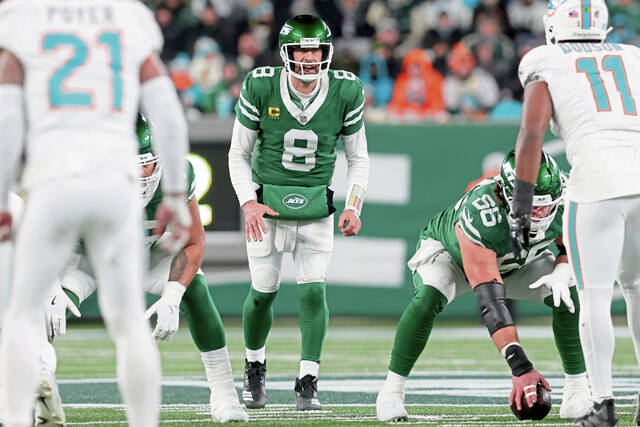Aaron Rodgers — finally — has joined the Steelers. Now what do they do?
If any of his new Pittsburgh Steelers teammates have an issue with Aaron Rodgers waiting until June to sign a contract to join the team, none of that will matter if and when Rodgers performs on the practice field during mandatory minicamp next week.
“If you come in and you’re on your stuff and you know what you’re doing and there aren’t a bunch of (screw-ups) here and there, I’ll have no issue with you,” veteran linebacker Patrick Queen said, speaking generally about absences by any player from organized team activities. “It’s different if you’re just showing up at the late part and you’re messing up here, messing up there. If you can’t get the wrinkles down, then it’s a problem.”
At 41 years old and with 20 seasons and 248 NFL games of experience to lean on, Rodgers is worth the wager that his proverbial hopping on the moving train will work as seamlessly as possible.
But even if Rodgers’ assimilation onto the team and into the offense is smooth, the Steelers have plenty of work to do in preparing for the start of training camp in seven weeks and the start of the regular season Sept. 7.
More throws?
It will be interesting to see how offensive coordinator Arthur Smith — known for a run-heavy mentality — adapts to having an all-time passer in Rodgers.
Smith has an interest in historical data, often citing numbers and statistics when explaining his offensive philosophies. He is probably aware that over the course of Rodgers’ career, he has averaged 34.4 passing attempts per start, and he was almost exactly at that number last season for the New York Jets.
With Smith calling the plays for the first time, the Steelers in 2024 averaged 29.4 passes per game — again, almost exactly in line with Smith’s tendency over six NFL seasons as a team’s primary play-caller (29.5).
Will Smith acquiesce to having an elite-level arm at his disposal for the first time? Even at age 41, Rodgers is probably a superior passer to the other quarterbacks Smith has called plays for: Ryan Tannehill, Marcus Mariota, Desmond Ridder, Taylor Heinicke, Justin Fields and Matt Ryan and Russell Wilson at advanced ages.
Another WR?
In addition to Rodgers Watch, a seemingly concurrent never-ending Steelers spring storyline was (is) the lack of a proven No. 2 wide receiver.
With the free-agent market well picked-through by now, where can the Steelers turn? Gabe Davis recently visited UPMC Rooney Sports Complex but left without a contract.
Many of the other top names available are in their 30s and coming off arguably the worst statistical seasons of their careers: Keenan Allen, Amari Cooper, Nelson Agholor, Tyler Boyd and Odell Beckham.
The trade market, of course, is another route. That opens up the possibility they pursue Allen Lazard. The 29-year-old has been on the roster with Rodgers for his entire NFL career, and the New York Jets are reportedly interested in trading him.
Lazard’s 17-game averages over the past three seasons in which he had Rodgers as his primary QB would slot in satisfactorily as the Steelers’ No. 2 wideout option: 55 catches, 733 yards, 7 touchdowns, 13.4-yard average.
Cap talk
Though the exact figure is not yet known, Rodgers is known to have taken a significant salary cut from what he was making in recent seasons for the Jets and Green Bay Packers.
Considering it’s a one-year deal, the cap hit should be rather straightforward. According to spotrac.com, the Steelers had $32.3 million in cap space before adding Rodgers. Even if he eats up $20 million, that leaves the team plenty of breathing room to add a receiver or reinforcements at other positions. And that doesn’t even take into account that there are more than a handful of veterans on lucrative long-term deals with multiple years remaining on them that are easy targets for a restructuring that would create even more space if it is needed.
In summation, the Rodgers signing will have no effect on the Steelers’ ability to give a potential extension to T.J. Watt.
Long-term solution
Rodgers is an adequate option for 2025. It would be unreasonable, though, to assume he’s the answer for anything past this year.
So where do the Steelers turn next in their seemingly endless quest to replace Ben Roethlisberger? Rodgers will be the sixth QB to start for them since Big Ben retired in January 2022. Assuming Rodgers starts the season opener, it will be the sixth starting quarterback in a span of 24 regular-season games.
For now, Mason Rudolph is a very good No. 2 to have, and as far as sixth-round picks go, Will Howard is worth a look.
Odds are, though, that for the third year in a row that by 2026 the Steelers’ starting quarterback will have not on the roster the year before.
If you’re tempted to look up the list of NFL quarterbacks who are set to be free agents next spring, do yourself a favor and don’t. Among the “best” options are three of the Steelers’ most recent five starters — Russell Wilson, Kenny Pickett, Mitch Trubisky.
That should say it all.
History tells us that by next spring, some veteran of repute will get released or request a trade. That market will remain fluid. But the Steelers have played that game now in three of the past four offseasons. They’re surely growing tired of it.
The best bet? What is expected to be a QB-rich draft class. With a bonus that the event is being staged in Pittsburgh, the Steelers have already been loading up the capital to target a, say, Arch Manning, Garrett Nussmeier, Drew Allar, Cade Klubnik or LaNorris Sellers.
Either way, we’re probably only about nine months away from yet another spin around the Steelers QB carousel.
Chris Adamski is a TribLive reporter who has covered primarily the Pittsburgh Steelers since 2014 following two seasons on the Penn State football beat. A Western Pennsylvania native, he joined the Trib in 2012 after spending a decade covering Pittsburgh sports for other outlets. He can be reached at cadamski@triblive.com.
Remove the ads from your TribLIVE reading experience but still support the journalists who create the content with TribLIVE Ad-Free.



